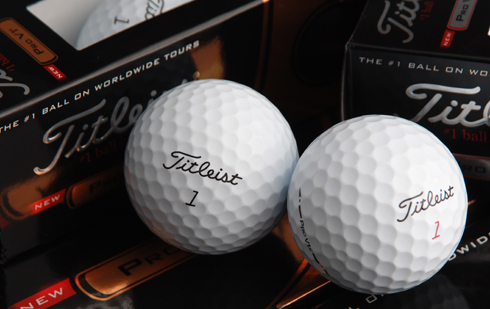 Titleist has had the number one ball on the market for as long as I can remember, and I have a few gray hairs. Every two years Titleist releases a new version of their high-end balls. I sometimes think that if it isn’t broke, don’t fix it. Titleist seems to use the mantra of “every moment we rest gives our competitors a chance to catch up.”
Titleist has had the number one ball on the market for as long as I can remember, and I have a few gray hairs. Every two years Titleist releases a new version of their high-end balls. I sometimes think that if it isn’t broke, don’t fix it. Titleist seems to use the mantra of “every moment we rest gives our competitors a chance to catch up.”
With that, Titleist has released all new versions of the Pro V1 and Pro V1x in an attempt to keep their competitors at an arm’s length and keep a tight grip on their tremendous market share. So how do you improve the number one ball on the market? Well, there are a few ways but you’ll have to read on to find out what those are and if it made a difference to this long-time Titleist player.
Design and Technology
The Pro V1 and Pro V1x both are multi-piece, solid-core golf balls. The Pro V1 is a three-piece ball and the Pro V1x is a four-piece ball. One of the new features is an upgrade to the cover of the ball, offering a higher performance urethane elastomer to improve durability.
The core of the Pro V1 and Pro V1x is where the two balls differ the most. While both are made of Polybutadiene, the four-layer Pro V1x sports a dual core design while the three-layer Pro V1 has a single core. The inner core of the Pro V1x is a 1″ diameter ball. The outer core surrounds it, and as a whole, the core is a bit larger than in the 2007 Pro V1x. The role is still the same: reduction of spin over Pro V1’s single core.

You can see the three layers of the Pro V1 and four layers of the Pro V1x (including the dual core). The Pro V1 is softer and spins more than the Pro V1x.
Outside the core, the remaining two layers of the Pro V1 and Pro V1x balls are the casing and the cover. While the core grew in size, the Ionomer casing was made a bit thinner. The cover, as mentioned before, has gotten a makeover to make it a bit more durable.
The 392 (Pro V1) and 332 (Pro V1x) dimple design with Staggered Wave parting line has not changed in either the Pro V1x or Pro V1. The A.I.M (Alignment Integrated Marking) on the side of the ball has subtly changed with a dot between the end of the line and the arrow. Not a big change, but a change none the less, and one that will differentiate the product from the 2007 version.
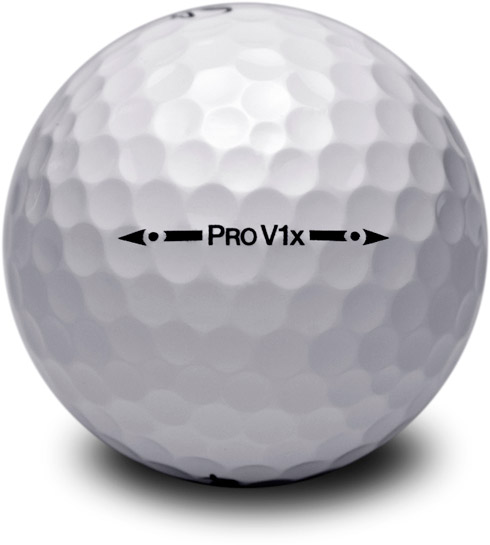 In general, the balls break down as follows:
In general, the balls break down as follows:
Pro V1
- Softer feel around the greens
- More spin leading to added workability with irons and more short-game “check”
Pro V1x
- Firmer feel around the greens
- Longer off the tee and straighter due to decreased spin
Feel and Spin
How a ball feels off the face of the club, especially around the green, is more important to my game than any other aspect, feature, or measurement. I know that the ability to control the ball the way I want in a consistent manner in the scoring area (80 yards and in) shapes my scoring more than distance off the tee, control in the wind, or anything else.
As advertised, the Pro V1 continues to be the softer ball of the two. With the wedge, you can hit an array of shots using the new Pro V1. Even on firm greens I was able to hit one-bounce-and-stop chips with ease. Half wedges and longer shots also had a decent amount of spin without overdoing it.
Once you ratchet up to a full swing with a lob or sand wedge you can put some serious spin on the Pro V1. It’s a bit more than I like, but players who are not able to normally put a lot of spin on the ball should be able to do so with the Pro V1. For comparison sake, it spins a bit more than what I experienced with the TaylorMade TP Red ball.
The Pro V1x also maintains its reputation as a lower-spin ball with a slightly firmer feel. Around the green you can still generate enough spin to get the one-bounce-and-stop action, but technique and clean contact matter a bit more. The new Pro V1x doesn’t stop quite as quickly as its sister ball, the Pro V1, but it’s got plenty of spin for this golfer. The action I can generate with the Pro V1x is just right. Full wedges hardly ever over-spin and normally will take the one hop, stop and pull back to where the ball landed – that’s Titleist’s “drop and stop” technology. Chips that I play to roll out do so without taking away the opportunity to hit the checking short shot. Like I said, it’s just right.
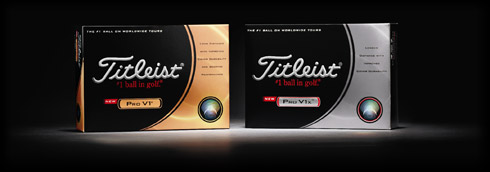
The Pro V1 and Pro V1x still maintain the feel and spin players around the world have come to trust.
On the green the Pro V1 has a very pleasant soft feel without being “mushy” soft. You still get feedback off the putter face. In this respect, I prefer the Pro V1 over the Pro V1x. I wouldn’t classify the Pro V1x as a bad ball to putt – it’s actually very good – but the Pro V1 is just a bit softer and feels a bit better on the green. The Pro V1x is still soft, but has a bit more of a “click” off the face of the putter.
The soft feel of both the Pro V1 and Pro V1x and the ability to consistently control spin is what makes the Pro V1 balls, in my opinion, the best out there. Current Pro V1 and Pro V1x players will find the new balls nearly identical in both feel and spin. The only thing I could barely notice was that the new versions felt a bit harder than their older counterparts. Not enough to make one change their preference though.
Distance and Durability
Titleist has touted the new versions of the Pro V1 and Pro V1x as longer. Anyone expecting a big, noticeable distance boost will be disappointed. The Pro V1x, of course, was the longer of the two balls. Most everyone would expect that. For this review, I took a sleeve of the 2007 Pro V1 and Pro V1x and hit some drives and irons along with the 2009 versions.
Comparing the ’07 and ’09 versions, I found that with the Pro V1, I gained a few yards off of the tee with the new version. Some golfers may not see any difference. The only time I saw a bit more length was with the driver as I saw no discernible difference with my irons.
My current ball of choice, the Pro V1x, performed surprisingly well in terms of distance. While I noticed only a few yards difference with the Pro V1, the gap between the ’07 and ’09 Pro V1x was often 10 full yards. As such, I’m a bit more comfortable in saying that the new Pro V1x is longer. Again, these results will vary by golfer and your individual launch characteristics, but I think that most will see positive results.
Finally, the last area that Titleist has hyped about the new versions of the Pro V1 – its durability. Typically I will stretch a single Pro V1x to last an entire round – assuming I don’t lose it. After that, it will usually go into a shag bag. I’m a bit picky about my ball’s appearance, so others may find another round in a ball that I’d throw away.
 Naturally the new Pro V1, because it is a softer ball, did not wear as well as the new Pro V1x. Compared to the 2007 Pro V1 though, the 2009 model held up a lot better. In fact, after nine holes with the Pro V1 there were only minor marks and the ball was close to new in appearance. The same can be said for the new Pro V1x against its older version. It didn’t finish with scuff marks, which I never seem to have a problem with unless a cartpath gets in the way, but the minor scratches and scrapes (and groove bite marks) were reduced or eliminated after the same amount of use. The newer models simply seemed more “useable” after a round or less of use.
Naturally the new Pro V1, because it is a softer ball, did not wear as well as the new Pro V1x. Compared to the 2007 Pro V1 though, the 2009 model held up a lot better. In fact, after nine holes with the Pro V1 there were only minor marks and the ball was close to new in appearance. The same can be said for the new Pro V1x against its older version. It didn’t finish with scuff marks, which I never seem to have a problem with unless a cartpath gets in the way, but the minor scratches and scrapes (and groove bite marks) were reduced or eliminated after the same amount of use. The newer models simply seemed more “useable” after a round or less of use.
This is good news given the most common criticism of the number one ball on the market: its price. With the 2009 models, you can expect a bit more return on your investment – and that’s something just about everyone will welcome.
Charting the New Ball
So how does the new ball stack up with the old? A few charts might help.
These graphs show three things: Driving Distance, Softness, and Spin from Irons. They use a relative scale of 1-10. There aren’t any actual measurements, and for the sake of comparison this 1-10 scale considers premium golf balls available today, like the Nike One, the Callaway Tour i, the TaylorMade TP, etc. Only Titleist’s new and old balls are charted, but you should consider the 1-10 scale as covering the entire premium ball category.
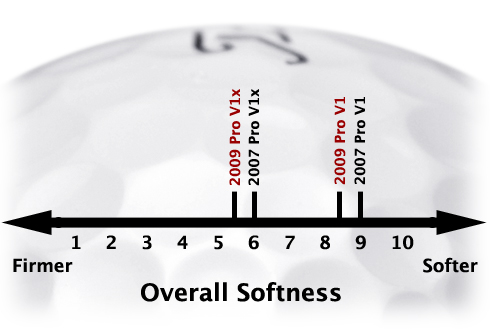
The ’09 Pro V1 and Pro V1x are slightly firmer than the ’07 version. I attribute this to the fact that the new ball is more durable and Titleist has sacrificed a bit of the softness to accomplish that. The difference is barely noticeable.
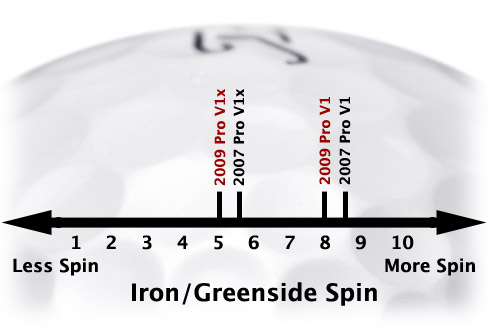
Along with being a bit firmer, the new Pro V1 and Pro V1x spin a bit less than their older counterparts. The good part about this is that none of the control and feel around the greens has been lost. Any shot you have been able to hit before remains possible with the new ball.
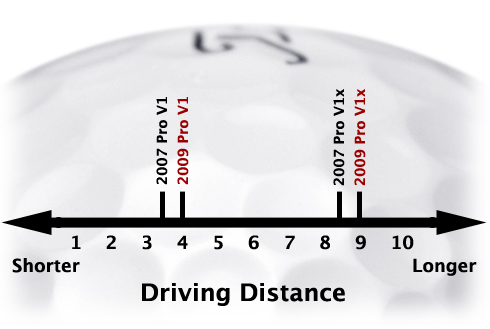
The best enhancement to the Pro V1 and Pro V1x is added distance. With what you lose in spin and softness, you gain back off the tee. Again, most of these changes are subtle and may be more noticable by different players. My guess is that most won’t notice a difference.
Not charted: durability. While the ’07 models were pretty average within their respective softer/spinnier and firmer/longer categories, the ’09 models would rank quite highly among all premium balls.
Conclusion
When you’re on top, it’s hard to climb any further. Despite that, the 2009 Pro V1 and Pro V1x have done just that. It wasn’t a leap or a jump – just a couple steps forward to keep the masses happy and coming back for more.
I’ve been playing Titleists since the latter days of the Balata and first generation of Professionals. I’m a loyal customer and have only been tempted once or twice to switch to other manufacturers but never made the jump. The newest update to the Pro V1 by Titleist will keep my business for the foreseeable future. The only switch I can really conceive of making at this point would be from the Pro V1x to the Pro V1.
For the price, I tend to look at it in simple terms. In a round of golf, the only piece of equipment you are guaranteed to use on every shot is the ball. Shouldn’t it be the ball you want to play and not a concession or compromise in order to save $0.35?

Great article! Well written!
I know a few of the golf pros around our area have been hesitant to make the switch. Not sure if that’s just because they are so attached to the previous model or an indictment of the new ball. I know you mentioned a negligible difference in feel but they are claiming a more substantial difference.
I’m anxious to try the new model but i switched to the callaway tour i last year because I liked it much better off the tee while getting proV quality around the greens. Looking forward to seeing how the new model stacks up.
Thanks for the review!
Great information thank you!
While I am starting in the “realm of using a better ball”, I find a lot of questions regarding brand comparisons. I know that Callaway Tour i and Bridgestone B330S are compared to the ProV1, and the Tour iX and B330RX compare to the ProV1X. What I am wondering is how do they match up? What about the Srixon or Nike models?
So far I have tried the ProV1 and B330S and I can not say which one I do not like. I am going to look at the ProV1X and RX next.
Just trying to find ones that are right for me. 😀
Yes
Nope. The B330 is Bridgestone’s “comparative” ball. Bridgestone has three: B330, B330-S, B330-RX, while Titleist only sees the need for two: Pro V1x, Pro V1.
does swingspeed matter?…the story from the ’07 versions of the ProV1 and ProV1x was that the “x” needed a high-swingspeed player to optimize the ball? i guess there is no truth to this? thanks
You’re right: there’s almost no truth to it. For the answer, check out our interview with Titleist about the balls.
General, short answer is this: once you get to a slower swing speed, some golfers can’t generate enough spin to maximize distance, and so the softer ball of the two (Pro V1) may be more beneficial to their game because it is also higher spin. But if you generate enough spin, Pro V1x should be fine for you.
Not only is the “minimum swing speed” question answered, but I’d encourage you to keep listening to hear the answer to the question about ball fitting, too. For most people, they could play either the Pro V1 or V1x, and choosing between them is important. It’s not all about distance when choosing between two golf balls.
Great review.
I’ve been using the new Pro V1x for 2 weeks now. It is definitely drives longer by a good 10 yards often more, spins a bit less but I prefer this. Might be a little bit longer of the irons but not much.
For my game the best ball on the market.
Why would you play anything else?
I’d love to see a SandTrap review of Callaway’s new balls. I’ve tried out almost all of the premium balls at some point or another, and I think Callaway’s are the closest to giving Titleist a run for their money. You guys write some of the best reviews out there, and it’d be really cool to see what Dave Koster thinks about them.
I recently switch from Pro-V1x (always played Titleist) to Callaway Tour ix. The Tour ix is (in my opinion) a better ball. It is longer, more durable (especially off Callaway X-Forged Wedges), the spin is consistent, and it plays very stable in the wind. I don’t think I will be going back to Pro-V1x.
Excellent review Dave, as always. A quick further clarification about the Bridgestone B330 balls vs. the Titleist Pro V1 lineup. As Erik pointed out, B330 is to Pro V1x as B330S is to Pro V1. B330RX is a softer, “spinnier” variant intended for lower swing speeds – people who need a little more help compressing the core and generating enough spin to get the ball on the right trajectory, but still want multilayer construction and a urethane cover. Interesting to see if any other companies follow suit with a “tour” ball aimed at the non-100mph swing speed crowd.
Golf Town in Canada is offering for this weekend only, a $3 reduction in the cost of a dozen ProV’s. Begs the question…Overpriced to begin with? The consumer will decide in a very short period of time what the actual price point is. It’s only me talking aloud, but the days of a manufacturer and retailer setting the price bar high for balls and equipment, are over.
I have been hitting V1Xs for about 3 years now. Even with the 2009 version the durability is not what I would expect from a $45 dozen of balls. I used to have Callaway X-Forged irons with the mack daddy grooves and they would shred the ball. I moved to Vokeys this spring and there is not as much damage to the ball, but the balls rarely last more than 9 holes.
I got some free Callaway Tour iXs last year in a tourney and they were way more durable. I will probably switch after my current supply of V1x runs out.
As a die-hard Titleist fan it hurts me to agree.
I have tried the new Callaway ix and it is superior to the 07 ProV1x in every respect. The new TP Red is dangerously close to be a better all-round ball also.
I have not tried the new 09 ProV1x ball yet (not available in Ireland for another 2 weeks), but will be anxious that it restores the advantage (especially after Callaways swipe at Titleist over patents).
All die-hard loyalists should note that Callaway are getting their act together. I recently demo’ed the new x-forged irons and they were superior to my zb’s in terms of feel, forgiveness and distance and the new FT9 tour outperformed my new 909D2.
The latest Golf Digest rated the Pro V1 and V1x as the only Gold ball in the category – quite suprising to me that there is only one Gold given the balls tested.
I just bought a dozen of the PRO v1x’s. What a bad decision. I love titleist and wanted to give them a chance, and the balls failed miserably. I am a +1 handicap and love the feel of them around the greens, but with my new Nike TW blades and wedges, these balls get cut with an iron into the green. Cut to the point where you dont want to tee off with it again next hole.
I am going to try the Callaway Tour ix’s, as I heard they have a more durable cover, also the Taylor made TP red or black have good covers. I like a ball that is going to last 9-18 holes, not 1-2. Sorry titleist for the bad review, but your cover is way to soft and for someone who is a low handicapper, they are going to look at cheaper alternatives.
The reviewer (Dave Koster) is a +1 handicap, you know. He’s played entire rounds with one Pro V1x, as have I (2 or 3 index).
eh Sean,,,I am a 7 and have the same opinon of proV’s…Golf Galaxy has a special now on Callaways, buy 12 get 6 free..so I bought the ixtour this week..did you notice a weird dimple that makes it look like a protrusion or a nick in about 4 or 5 places?…guess it’s some aerodynamic crap but it just looks strange.
Played the 09 ProV1 on Saturday, having used the Cally HX Tour 56 for the past couple of years.
The putting feel/sound is the one major thing I notice with the V1 against all other premium balls (including the V1x). It just feels better to me and fills me with confidence (can I interest anyone in a placebo? LOL).
One question for Dave, did you notice much difference in ballflight between the new V1 and V1x.
I’ve got a few of each put aside to test side-by-side this weekend, but I am interested in your opinion, having read, and really enjoyed, your review.
Titleist will tell you that the Pro V1 launches about a degree lower than the Pro V1x. I’m guessing that’s an average, and of course you could create situations where the launch was the same or 10 degrees different, but in my experience that seems to hold: “slightly lower.”
But Dave’s a better golfer than I am currently, and he hits the ball lower than I do naturally, so I’ll email him to pay attention to your question too.
Erik is right, I have a lower ballflight than most. That being said, the Pro V1 was a bit lower than the V1x. It wasn’t very noticable or ever became a decision point that would sway me one way or the other. The X just fits my swingspeed and spin requirements better than any other ball out there.
Sweet. I’d actually read the x was lower, so obviously that was misguided. Hard to go past the side-by-side test, but the above was really interesting, thanks.
As a general rule, the spinnier/softer balls tend to launch lower than the firmer/lower-spin balls regardless of who makes them.
Played the Callaway ix for the 1st time. wind was blowing here in SFL over 20mph and I was very pleased. Also it was a pure white after the round not that dirty white that ProV’s turn into after a round or two.
Just bought a dozen of 09 Pro V1x but didn’t seem to gain much distance if any compared to the Callaway Tour i. This is definitely a great ball though, makes it much easier to hit high/low or left/right
Hey everyone first time posting on here. I’m currently at Myrtle Beach for vacation and have played two quality courses; Indigo Creek and The Surf Club. My dad gave me a couple sleeves of the new Pro v1x and I couldnt be more impressed. The distance I picked up off the new titleist is at least 10 yards and the spin into greens is great. With the Pro v1 you have to take more club to counteract the spin but with the x all you have to do is maybe add 1 or 2 yards and take your normal swing. Durability is as good as ever considering I used the x for two rounds until it found a pond on the 17th at The Surf lol. Highly recommend to anyone looking to improve their game.
I am an 8 handicap and had been playing the Prov1 for nearly 5 years when I got into single digit. Just lately made the switch to the X ball. Somewhat lower ball flight for me and same distance but still able to get it to drop and stop. I have been buying One-Hit-Wonders in “Mint” condition off the internet for about 3 years. Issues with being on pension and SS and all that stuff. Now they have gone to about $26.00/dozen. Okay, trying to drop my financial output on balls. Tried Callaway “I and IX”. Much too hard off my putter face for my feel. Was just advised to try the 2009 version of the TaylorMade TP Red or Black. I was astounded. Came off the course after playing the Red and there was no difference in ball flight or distance to the Prov1x and the drop and stop factor was excellent. Didn’t try the black because I don’t like balls that back up 25 feet. Feel off the putter is excellent…at least as soft as the prov1. And, I can buy these new for $27.50/dozen versus $26/dozen used for the Titliests. An absolute no brainer. As far as durability is concerned, I understand this was an issue for the earlier version of this ball but I can say that I used two balls for the entire round yesterday. Lost the first one on a pure shank on the 4th. hole into the water. Played the last 14 holes with one ball and at the end, there was absolutely ZERO discernable wear and tear on the ball. Highly suggest these balls folk.
I’ve been using the prov1x for a long time now and I recently tried the Bridgestone B330 RX. It is a great ball, goes further then the pro v wears better, stops on the green and they are cheaper. I play off a 7 handicap. Can’t say any thing more.
Just a note on the TP Red/Black…the Red is more like the ProV1 and the Black more like the ProV1x.
Red spins a bit more but Black goes a bit further.
I switched from ProV to Reds because they’re half the price and love the ability to work the ball.
That used to be true. The LDP models of each ball flipped some of the performance characteristics. The Black launches higher and spins more. The Red launches lower and spins less.
Whats up with the tp red ldp tournament edition.
hey, so ive been using the top flite balls for about 2 or 3 years now and i drive about 240-250 yards on avgerage. which ball would be better for me? the Pro v1 or the Pro v1x?